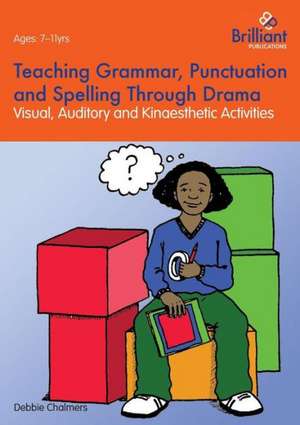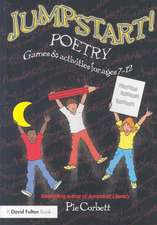Teaching Grammar, Punctuation and Spelling Through Drama - Visual, Auditory and Kinaesthetic Activities
Autor Debbie Chalmersen Limba Engleză Paperback – 3 apr 2013
Preț: 136.65 lei
Nou
Puncte Express: 205
Preț estimativ în valută:
26.15€ • 27.37$ • 21.64£
26.15€ • 27.37$ • 21.64£
Carte disponibilă
Livrare economică 15-29 martie
Livrare express 04-08 martie pentru 18.96 lei
Preluare comenzi: 021 569.72.76
Specificații
ISBN-13: 9781783170227
ISBN-10: 1783170220
Pagini: 82
Dimensiuni: 210 x 297 x 4 mm
Greutate: 0.22 kg
Editura: Brilliant Publications
ISBN-10: 1783170220
Pagini: 82
Dimensiuni: 210 x 297 x 4 mm
Greutate: 0.22 kg
Editura: Brilliant Publications
Notă biografică
Debbie is an early years, primary education and drama consultant.
Cuprins
Introduction. GRAMMAR ACTIVITIES: Is that your name? (Proper nouns and common nouns); Tell me more (Adjectives that describe nouns); Which one? (Adjectives of order); As clever as that (Nouns and adjectives in similes); To do it together (Verbs - root forms); Now or later? (Verb tenses); Who will do it? (Active and passive verbs); Describe it to me (Adverbs of manner); When was that? (Adverbs of time); Where shall we go? (Adverbs of place); Constructing theories (Connectives/conjunctions - single words); All link up (Connectives/conjunctions - two or more words); Opposite ideas (Prefixes to change meaning); This way or that way? (Suffixes to change meaning); Different forms (Suffixes to change tense or type of word); Who's it? (Pronouns - to replace nouns); His or hers? (Pronouns - singular or plural and possessive); Combining words (Compound adjectives - using hyphens); Where are you now? (Prepositions - relative positions); Say it carefully (Word order - for meaning); Be my partner (Clauses that work alone but may be joined); Lift us out (Subordinate clauses); Excuse me (Degrees of formality - strangers, requests, complaints, occasions and events); Quite correct (Degrees of formality - school, books and essays); Familiarity (Degrees of formality - home, family and friends); Could you tell me? (Asking and answering questions); Do as I say (Giving orders and commands); Break it down (Using paragraphs). PUNCTUATION ACTIVITIES: Taller than some (Full stops and capital letters to make sentences); May I ask you? (Using question marks); How amazing! (Using exclamation marks); Find the links (Commas to divide clauses); Wait a moment (Commas to create pauses for reading aloud); Keep us apart (Commas to separate items within a list); Ready to speak? (Commas in complex sentences and speeches); That one's mine (Apostrophes to indicate possession); What's missing? (Apostrophes to indicate missing letters or words); And then - (Using an ellipsis); What did he say? (Inverted commas in speech and dialogue); Is that true? (Inverted commas used for effect); Make a report (Inverted commas used in exact reporting); What happened next? (Dashes); And also - (Brackets to enclose extra information); And by the way - (Brackets to add an aside); I'll tell you more (Brackets to give further explanation); On the other hand (Semi-colons to separate or balance contradictions); I don't think so (Semi-colons to separate or balance preferences or opinions); Is there a reason? (Semi-colons to separate or balance explanations or comparisons); A whole group (Colons before lists); Your turn (Colons before speeches or instructions). SPELLING ACTIVITIES: Begin to rhyme (Initial letters and rhymes); Make a pattern (Common spelling patterns); Spells of wizardry ('Magic e' words); Already happened (Adding 'ed' to regular words to make the past tense); Scare him off (Adding 'ed' to words ending in 'e'); Double time (Adding 'ed' and doubling consonants); Do it now (Adding 'ing' to regular verbs in the present tense); Swap with me (Adding 'ing' to words ending in 'e'); It takes two (Adding 'ing' and doubling consonants ); More of us (Regular plurals - adding 's' or 'es'); Yes, I'm coming (Irregular plurals - words ending in 'y'); Change the letter (Irregular plurals - words ending in 'f'); Leave me alone (Irregular plurals - words that stay the same); Mix up (Unusual plurals); End it now (Word endings - that sound the same and are often confused); How does it end? (Word endings - that can be hard to remember); Quietly does it (Silent letters as initials); Not a sound (Silent letters within words); Hide inside (Spelling longer words - by finding smaller words inside them); Put us together (Spelling longer words - by joining words together); What do you hear? (Homophones); Which way round? (Words containing 'ie' or 'ei'); Catch the beats (Syllables). Index of learning objectives.














